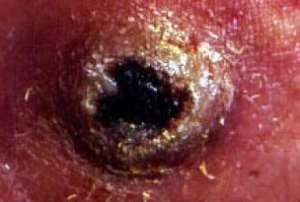
Kaposi's sarcoma diseases in Africa are said to be aggressive and to strike young people in particular. Yet, from 1872 to 1950, reference literature quoted 14 white people, yet not a single black child under the age of 15 years.
Then from 1950 to 1959, suddenly 18 black children on in Africa and six white children in the rest of the world were registered. The only showed completely new symptoms: 'Kaposi's sarcoma is unique in the lymphadenopathic type of the disease occurs only in African children, in other parts of the world, children and adults never develop this form of Kaposi's sarcoma.'
This lymphadenopathic form also occurred among patients whose immunosystem was partly intentionally disrupted by medications (for example, by cortisol during organ transplants) and in connection with Aids. And tumors settled on the eyelids and conjunctiva were also only prevalent among children in Africa, and nowhere else in the world.
Such growths lead one to conclude that large quantities of agents must have been transmitted by air. As stated in the leading article in Lancet in 1973, and indirectly confirmed by Safai, it is quite inexplicable that Africans are not troubled by further malignant diseases besides Kaposi's sarcoma, like the counterparts in Europe and North America.
There is generally no susceptible to malignant diseases among the Kaposi's sarcoma cases in Africa.
Kaposi's sarcoma as a result of medical immuno-suppression
In cases of immuno-suppression, (for example, following organ-transplants), some persons of Jewish or Italian origin develop Kaposi's sarcoma. In Toronto, 500 kidney-transplants were carried out between 1958-1978, followed by subsequent immuno-suppression by medications. Of those, one hundred were persons of Jewish-Mediterranean origin.
Four, exclusively of these hundred immunosuppressed patients, developed the highly rare Kaposi's sarcoma, whilst out the remaining 400, there were kidney-transplants not a single one. In Australia and New Zealand on the other hand, out of 1,884 kidney-transplants, not a single person developed Kaposi's sarcoma.
However, in Israel with just 100 kidney-transplants, there were four new cases of Kaposi's sarcoma. The Israeli scientist Nissenkorn, maintained, "the conditions prevailing in Israeli contain some unknown contributory factor."
From a total of 32 reported Kaposi's sarcoma patients following organ-transplants, eight were designated as being the Jewish-Israeli origin and five as Italians.
No allusion was made to any black skin-coloring. Two-third were men, whilst nevertheless, 1/3 were women. (Ratio in spontaneous cases 19:1) Kaposi's sarcoma frequently develops immediately, after such cortisol treatment is administered.
This shows cortisol not to be causing Kaposi's sarcoma, but rather an agent, which is only existing in some Jewish-Italian people, and which is kept in check, especially in women, by control mechanisms.
As soon as these control-mechanisms are weakened by cortisol, the agent is free to reproduce.




 This IMANI job no dey pap; the people you are fighting for are always fighting y...
This IMANI job no dey pap; the people you are fighting for are always fighting y...
 Prof. Naana Opoku-Agyemang has changed; you can see a certain sense of urgency –...
Prof. Naana Opoku-Agyemang has changed; you can see a certain sense of urgency –...
 MFWA Executive Director slams Akoma FM for engaging in ‘irresponsible’ media pra...
MFWA Executive Director slams Akoma FM for engaging in ‘irresponsible’ media pra...
 ‘Women must become millionaires too’ — Prof Jane Naana on establishment of Women...
‘Women must become millionaires too’ — Prof Jane Naana on establishment of Women...
 Some believe only in Ghanaian votes, not Ghana — Kofi Asare jabs politicians
Some believe only in Ghanaian votes, not Ghana — Kofi Asare jabs politicians
 Plan to make BEST sole aggregator of Sentuo Oil Refinery will create market chal...
Plan to make BEST sole aggregator of Sentuo Oil Refinery will create market chal...
 2024 elections: I can't have the man I removed from office as my successor — Aku...
2024 elections: I can't have the man I removed from office as my successor — Aku...
 2024 Elections: Immediate-past NPP Germany Branch Chairman garners massive votes...
2024 Elections: Immediate-past NPP Germany Branch Chairman garners massive votes...
 Gov’t focused on making Ghana energy self-sufficient, eco-friendly – Akufo-Addo
Gov’t focused on making Ghana energy self-sufficient, eco-friendly – Akufo-Addo
 April 25: Cedi sells at GHS13.74 to $1, GHS13.14 on BoG interbank
April 25: Cedi sells at GHS13.74 to $1, GHS13.14 on BoG interbank
